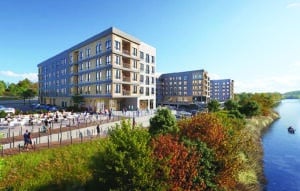
In Haverhill’s Bradford neighborhood, The Procopio Cos. is redeveloping a portion of riverfront as a multifamily project known as The Beck. The 7-acre site includes the former Ornsteen Heel shoe manufacturing property. Image courtesy of Cube 3
Over the course of the past decade, as pricing has increased throughout Greater Boston, developers have turned their attention to Massachusetts’ Gateway Cities. Though many Gateway Cities have seen a boom in development, there are still strong opportunities and incentives for consideration.
Gateway Cities may have land available, but they also offer robust redevelopment opportunities given the old mills and factories that remain post-industrial decline. Certain cities, like Haverhill – where we at The Procopio Cos. are developing a 290-unit mixed-use project, The Beck – have optimized this opportunity for development. They have recognized that people are seeking out experiences when selecting a location to live.
In recent years, Haverhill has completely revitalized its downtown, cleaned its waterways and established public parks and trails for the greater community’s use. Gateway Cities that take this approach can provide residents with the best of both worlds: the conveniences of urban living, and the opportunity for suburban respite. Lowell is another excellent example, as the city invested in restaurants and entertainment opportunities, drawing in a new demographic.
In our increasingly hybrid world, accessibility to public transportation has also become important, and many Gateway Cities offer robust local transportation options, in conjunction with routes that provide access to Boston. The seemingly permanent shift to hybrid and work-from-home models has caused an increased interest in Gateway City locations, as they allow individuals and families to justify dwelling further from the city, paying less while still maintaining an urban lifestyle and the ability to access an office downtown. Gateway Cities have recognized that a new demographic of residents seeking this lifestyle brings disposable income, which can be utilized to further expand the greater community’s growth.
At Procopio, we’ve approached our Gateway City developments as an opportunity to introduce product into locations that haven’t seen substantial redevelopment until recently. Although interest in Gateway Cities has increased in recent years, there are still ample opportunities available for consideration. Financial incentives are an excellent way to pencil projects, but the reality is they vary from city to city.
That said, if developers can lean into incentives, and think creatively about each development, there are substantial deals to be done. There are also strong tax incentives at the state and federal level, including flexible financing for transit-oriented developments, that can be utilized alongside local incentive opportunities. Each asset may provide unique incentives, so diligence and creativity are crucial. Strong collaboration between developers and cities remain imperative, as a collaborative effort can in many instances lead to greater incentive opportunities.
A Municipal Vision Pays Dividends
City improvements lead to development, which in turn can lead to even further city improvements. This can certainly be seen in Haverhill, where in 2020 officials established Vision Haverhill 2035 to reshape their city. They committed to riverway cleanup as a part of this plan, and the Merrimack River is now a major asset and amenity to Haverhill residents and a draw to developers like us – we placed The Beck adjacent to the riverside.

Bryan Vitale
As Gateway Cities like Haverhill continue to adapt, we anticipate a variety of demographics will be drawn to them, from empty nesters to young professionals, to single-family-homeowners who are now seeking a greater community experience. Whereas in the past a stark difference could be noticed between 30- and 50-year-old residents’ desires, this gap has blurred, particularly when it comes to convenience, community, recreation and food and beverage offerings.
Cities and urban developments offer a chance for socialization which continues to remain a focus for residents. Gateway Cities, alongside developers, should continue to establish strong community models, where convenience is the number one amenity, and residents can easily access amenities outside of the home, from nightlife and golf to public transit and outdoor space.
As Gateway Cities adapt, I anticipate developers will continue to find creative ways to expand their portfolios into these areas. In the future, we will likely see Gateway Cities as extensions of Greater Boston, instead of separate entities unto themselves.
Bryan Vitale is senior vice president of strategy and investments at The Procopio Cos.





